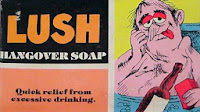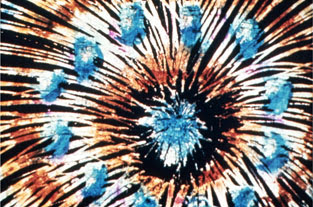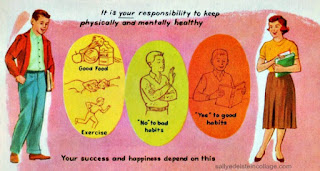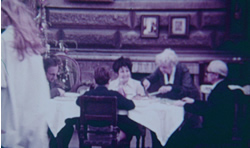Oddball Films presents Oh Canada! The Best of Canadian Animation, a program of 16mm cartoons all from Canadians, eh! Clever, hypnotic, mind-blowing, and often politically progressive this program highlights the work of some of the best innovators Canadian animation has to offer. The brilliant experimental animator and director of the National Film Board of Canada, Norman McLaren gives us two breathtaking works of pixilation animation. We'll begin with his Opening Speech. In Neighbors (1952), McLaren presents a much darker world (in beautiful color) where neighbors come to words, then blows, then bombs over who gets the beautiful flower that grows between their houses. Yellow Submarine animator Paul Driessen gives us a strange vision of the Inquisition in a spider's web in Cat's Cradle (1974). From the Oscar-nominated Caroline Leaf, the astounding sand animation based on Inuit legend, The Owl Who Married a Goose (1976). Evelyn Lambart's delightful cut-out animation Fine Feathers (1968) features birds that trade their feathers for foliage. With more cut-out creativity from Grant Munro and Gerald Potterton in the stylish mid-century My Financial Career (1962) based on Stephen Leacock's witty essay. What on Earth? (1966) brings us a martian's point of view of our auto-obsessed world. For some musical mayhem, we've got the eye-popping and surreal animated trip that is Brad Caslor's Get a Job (1985). In honor of the season, we bring you the delightfully strange Christmas Cracker (1964) featuring 3 odd Christmas vignettes from the brilliant Norman McLaren among others, and Jeff Hale's The Great Toy Robbery (1963), where Santa is held up by bandits in the Old-West. Plus, more pre-show surprises from our neighbors to the North!
Venue: Oddball Films, 275 Capp Street San Francisco
Admission: $10.00 Limited Seating RSVP to RSVP@oddballfilm.com or (415) 558-8117
Web: http://oddballfilms.blogspot.com
Web: http://oddballfilms.blogspot.com
Featuring:
The Sweater (Color, 1980)
Wonderful coming of age/mortified youth story written and narrated by Canadian novelist Roch Carrier. The film is about his trials when he is forced to wear a Toronto Maple Leafs hockey sweater rather than his favorite, rival team the Canadiens. The story is widely considered an allegory for the linguistic and cultural tensions between anglophone and francophone Canadians, and is an essential classic of Canadian literature (it is even featured on the back of the Canadian $5 bill). A Leonard Maltin favorite, the animation is by Sheldon Cohen.
Featuring Norman McLaren himself, he tries to master a recalcitrant microphone at the opening of the 1st Montreal International Film Festival. At every turn, McLaren finds himself duped by the wily mic. McLaren gives a performance worthy of Tati’s Monsieur Hulot or Peter Seller’s Clouseau.
Utilizing the new technique of animating live actors (fellow NFB animators Paul Ladouceur and Grant Munro), the Oscar-winning Neighbours is Norman McLaren’s most famous and important film. A parable of aggression and war, two men sit peacefully in lawn chairs when a flower appears on the boundary of their properties. In the quarrel that ensues the flower is destroyed, and the men turn to demons, destroying everything, including themselves.
This animated film that was written, directed, and animated by Brad Caslor presents all the frustrations, anxieties, and absurd hurdles of the job hunt in a funny and entertaining story. A cartoon dog gets booted out of one job interview after another, always being nagged by a group of grotesque looking singing pigs and heckled by a posse of singing bum animals. Finally, after a nightmarish trip through yet another series of interviews, the dog lands himself a job. Great music mixed with great, colorful animation, make this yet another gem from the National Film Board of Canada that is not to be missed!
Caninabis - The Junky Dog (Color, 1979)
Yes, you read that right: CANINABIS! This head-scratcher from the National Film Board of Canada chronicles the animated exploits of a scruffy street dog, who develops a taste (and smell) for that sticky icky icky, but uses his powers to help the police, where he is rewarded with huge joints for every drug bust. But when the weed starts playing tricks on his mind, the scruffy mutt drops the ball and ends up on the street again, chasing tailpipes for one more high!
![]()
My Financial Career (Color, 1962)
A wry and stylish retelling of Stephen Leacock's essay, directed by Gerald Potterton with fabulous mid-century cut-out animation by the great Grant Munro. A man tries his best to start a bank account only to get so overwhelmed by the institution, he bungles the whole transaction.
![]() Cat’s Cradle (Color, 1974)
Cat’s Cradle (Color, 1974)
Directed by Dutch animator Paul Driessen, one of the principle artists who worked on “Yellow Submarine” (and immigrated to Canada in 1971 to join the NFB), this curious piece is reminiscent of the Blue Meanies style, but with a darker tone. Witches, cloaked riders and other gothic characters in a tale about the hungry natural world.
Caninabis - The Junky Dog (Color, 1979)
Yes, you read that right: CANINABIS! This head-scratcher from the National Film Board of Canada chronicles the animated exploits of a scruffy street dog, who develops a taste (and smell) for that sticky icky icky, but uses his powers to help the police, where he is rewarded with huge joints for every drug bust. But when the weed starts playing tricks on his mind, the scruffy mutt drops the ball and ends up on the street again, chasing tailpipes for one more high!
A charming cut out animation from Norman McLaren's frequent collaborator Evelyn Lambart. Two birds try to show each other up by trading their feathers for foliage and both end up paying the consequences when the wind ruffles their leaves.

My Financial Career (Color, 1962)
A wry and stylish retelling of Stephen Leacock's essay, directed by Gerald Potterton with fabulous mid-century cut-out animation by the great Grant Munro. A man tries his best to start a bank account only to get so overwhelmed by the institution, he bungles the whole transaction.
 Cat’s Cradle (Color, 1974)
Cat’s Cradle (Color, 1974)Directed by Dutch animator Paul Driessen, one of the principle artists who worked on “Yellow Submarine” (and immigrated to Canada in 1971 to join the NFB), this curious piece is reminiscent of the Blue Meanies style, but with a darker tone. Witches, cloaked riders and other gothic characters in a tale about the hungry natural world.
A mesmerizing sand-animation based on an Inuit legend touting the consequences of not staying true to your own nature. Made for the NFB by the always innovative Caroline Leaf who experimented with multiple forms of animation, from sand-animation to paint-on-glass. Leaf was nominated for an Academy Award for The Street (1976).
![]() What On Earth! (Color, 1966)
What On Earth! (Color, 1966)
 What On Earth! (Color, 1966)
What On Earth! (Color, 1966)If aliens looked at planet Earth from outer space, what would he or she see? In this film, automobiles are perceives as life forms – with particular habits and behaviors! See beautifully animated lines of cars, dancing figures and stoplights, and other objects dancing. This psychedelic simplified world of shapes and signs, emphasizes consumerism and the ways in which earthlings are being conditioned! Produced by the National Film Board of Canada and directed by Les Drew and Kaj Pindal.
Great Toy Robbery (Color, 1963)
Christmas Cracker (Color, 1964)
A witty seasonal pleasantry consisting of three animation segments, employing tricks in movie magic by National Film Board of Canada artists and animators, including famed animators Norman McLaren, Grant Munro and with specially arranged music. Three scenarios are presented: A jester mimes introductions to each act, the first of which is a play on Jingle Bells in which a boy and a girl of paper cutouts move to the music. There follows a dime-store rodeo -- a whirring, hopping, ballet of tin toys done in animation to jazz composition. The third act is a tall tale of a Christmas tree trimmer who needs a star to top his tree and builds a space vehicle to pluck one from the sky.Great Toy Robbery (Color, 1963)
Acclaimed Canadian animator Jeff Hale ascribes a not so fortunate tale of Santa and the Wild West. With a structured and mechanical aesthetic, Hale erects a cartoon world full of good, bad, ugly and in between. A beautiful and sprite sound design completes the work, giving it a quality of magic, kind of like Santa Claus himself. Hale is best known for his work on a variety of animated television programs including Transformers, The Charlie Brown and Snoopy Show, and Stanley, the Ugly Duckling.
Curator’s Biography
Kat Shuchter is a graduate of UC Berkeley in Film Studies. She is a filmmaker, artist and esoteric film hoarder. She has helped program shows at the PFA, The Nuart and Cinefamily at the Silent Movie Theater and was crowned “Found Footage Queen” of Los Angeles, 2009. She has been scouring the archive for the best and worst of international animation for over 4 years.
Oddball films is the film component of Oddball Film+Video, a stock footage company providing offbeat and unusual film footage for feature films like Milk, documentaries like The Summer of Love, television programs like Mythbusters, clips for Boing Boing and web projects around the world.
Our films are almost exclusively drawn from our collection of over 50,000 16mm prints of animation, commercials, educational films, feature films, movie trailers, medical, industrial military, news out-takes and every genre in between. We’re actively working to present rarely screened genres of cinema as well as avant-garde and ethno-cultural documentaries, which expand the boundaries of cinema. Oddball Films is the largest film archive in Northern California and one of the most unusual private collections in the US. We invite you to join us in our weekly offerings of offbeat cinema.
Our films are almost exclusively drawn from our collection of over 50,000 16mm prints of animation, commercials, educational films, feature films, movie trailers, medical, industrial military, news out-takes and every genre in between. We’re actively working to present rarely screened genres of cinema as well as avant-garde and ethno-cultural documentaries, which expand the boundaries of cinema. Oddball Films is the largest film archive in Northern California and one of the most unusual private collections in the US. We invite you to join us in our weekly offerings of offbeat cinema.


























































































































































